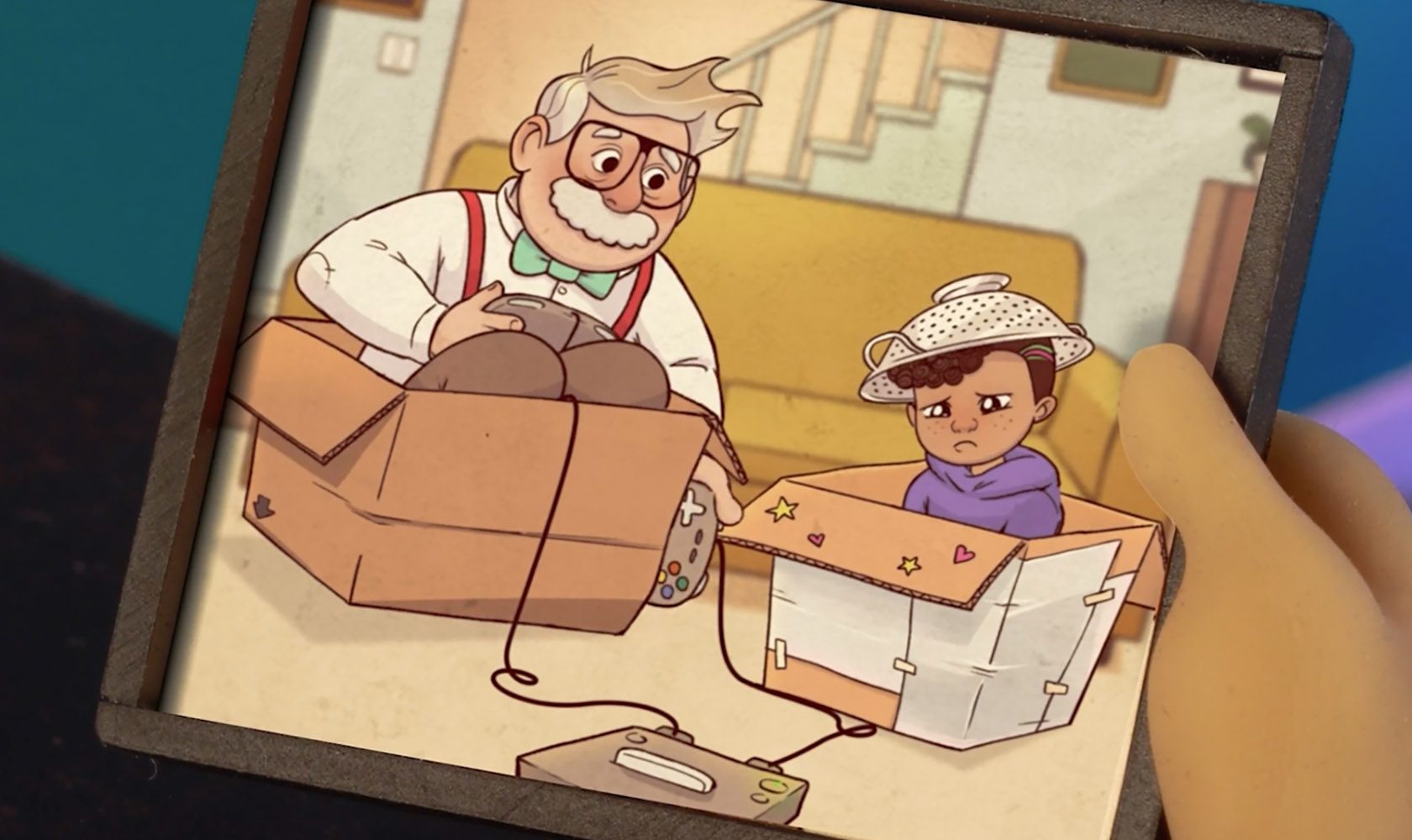31st October 2023
- A+C News
What The Heck is The Metaverse?
You might think stop-motion and the Metaverse aren’t going to meet, and you’d be wrong and wronger. A+C continually seeks ways to take traditional stop-motion techniques and twin them with technical innovation, and the Metaverse has us excited. When we’ve been raving about the Metaverse, we receive a lot of blank looks and comments like ‘The Mark Zukerberg thing?’, so we’ve written this brief explainer so you can take a deep dive into the verse too.
First and foremost, Mark Zuckerberg is NOT the Metaverse. He owns Meta, the parent company of Facebook, and neither Zuckerberg nor Meta controls the Metaverse. No one owns the concept of the Metaverse. It is an amalgam of companies, nonprofit standards organisations, open-source projects, research groups, and individuals. It has no owner, just like the Internet has no owner.
Zuckerberg has publicly referred to his company as “Metaverse” rather than “Meta” a few times, confusing people. Snake.
History of the Metaverse
So, onto what the Metaverse is. Let’s cover a bit of recent history. During the mandatory lockdowns, digital experiences were roaring. And, importantly, they were generating profit. The young and young at heart sought out escape and connection in the virtual world. Animal Crossings: New Horizons was released at the start of the lockdown. In it, players build and upgrade houses and befriend local animals. By the end of the lockdown, it had sold 37 million copies, and it wasn’t just games that people were buying into. Fortnite has grown its user base to 350 million since 2017. In 2020 alone, its users generated £4.1 billion in revenue from selling digital accessories. That means accessories you buy for your in-game character – not physical items you can use or wear yourself. Fortnite has also held digital concerts, which have attracted over 10 million attendees. Take a moment to think about those big numbers.
So, you’re either impressed by these figures or feeling a bit sceptical. After all, not everything is fun and games. But that doesn’t mean there isn’t a place for you or your brand in the Metaverse. As the Metaverse develops, there’ll be opportunities for all walks of life to participate, whether using it as an immersive digital workplace or allowing customers to test out real-world products digitally using simulation technology. You may be using the Metaverse in ways we can’t yet imagine.
So, what exactly is this Metaverse?
Explaining the Metaverse has the same elusive quality as describing the Internet to our Nans. A quick Google search for “What is the metaverse?” will take you on a journey that twists and turns and doesn’t go anywhere. It isn’t a clear concept. The lack of a de facto definition is a product of the times, with ‘experts’ trying to define something that hasn’t been fully realised yet.
The Metaverse is a virtual universe made up of worlds that builders create. Confusingly, these worlds are also called “metaverses,” but to simplify here, we’ll use the term “Metaverse” to refer to the whole virtual universe that contains these different worlds. Are you okay, you holding up?
Some worlds use a web browser as their point of access, like Decentraland. Some use gaming consoles and virtual reality headsets for a deeply immersive experience. VR is where people can meet, collaborate, and share experiences like going to a gig. Look at the Metaverse as a sophisticated communication tool where you can fully immerse yourself socially, professionally, and commercially. For instance, you might end up not only working remotely but working virtually. Your office could be in the Metaverse, and your commute could be as simple as wearing your VR headset. As soon as you’re in, you’ll be able to walk around, attend meetings that could have been an email, sit at your desk and work, and chat with colleagues as you pass them in the corridor. Because of this complete immersion, many believe the Metaverse will supersede the Internet as we currently know it.
The concept of these virtual realms isn’t new. Neal Stephenson’s novel Snow Crash depicted the Metaverse in 1992 – long before the Internet had made its way into our homes. This novel coined Metaverse and avatar– the digital version of you in virtual worlds. But what’s given the Metaverse its momentum is a shift in attitude toward digital assets.
Digital assets refer to anything that exists in the digital world – files, emails, and videos. Essentially, it means piles of data. Until 2021, these assets rarely had a defined monetary value. But all that changed in the second year of the pandemic.
Enter NFTs. These little bundles of data form something tangible – a unique avatar, an artwork, a song, a trading card, or virtual furniture to kit out your virtual house. NFTs are coded so they can’t be copied, making them exclusive. And in 2021, they became a must-have Metaverse item, so much so that £9 billion worth of NFTs were traded that year alone. Read our article on NFT’s here.
Suddenly, owning an NFT was like owning a Banksy. The advent of NFTs has given digital assets value in the eyes of society. And that value creates a substantial earning potential for companies making digital assets, along with the architects and designers who create virtual spaces for people to house their digital collections.
Now that you know the Metaverse, we’ll take a quick look at its technology. Remember that we’re currently in Metaverse 1.0. And that means technology will continue to develop. There will be a version 2.0, 3.0, and so on. On the other hand, certain fundamentals will remain the same. One of these fundamentals is the view that every user should be able to personalise their Metaverse experience – like the appearance and wardrobe of their avatars or the shape and style of their houses. Because of this, the Metaverse needs to be built with tools that work across all kinds of different platforms and allow for all the endless variations that users might want. This means users won’t be forced to choose assets from a predetermined range, like when you buy something off the shelf in the physical world. Instead, they can tell their building tool what they want, and it will modify its files to accommodate that, making every user’s experience bespoke.
At the moment, Unity and Unreal Engine are the two primary tools builders are using to create the foundation of the Metaverse. You can also find various 3D modelling tools like AutoCAD or Cinema 4D. Creators can make whatever they like in these programs – houses, animated pets, jetpacks – and then integrate them into the Metaverse using Unity or Unreal Engine.
So, that explains how the Metaverse and all its assets are created. But it doesn’t explain how you end up with commercial digital products that can’t just be copied and given to every avatar in your virtual neighbourhood.
The Metaverse is based on the blockchain system. Blockchain records information, so hacking, copying, or editing is almost impossible. Think of it as a giant journal that records the DNA of everything in the Metaverse, from avatars and assets to commercial activities and event participation.
Blockchain allows creators to develop one-off digital assets, like NFTs. With blockchain working in the background, it’s impossible to replicate the NFTs, and you can also verify their authenticity. This puts creators of digital assets in the same position as manufacturers and retailers of products in the physical world. For instance, if you go to Sports Direct and buy a pair of trainers, you can’t take them home, copy them, and give everyone you know their own pair. Blockchain guards the integrity of virtual world assets in the same way.
Before you can acquire any digital assets, you’ll need an e-wallet. This wallet is attached to a blockchain address that holds your ID in the Metaverse, just like your physical-world wallet has your driver’s license. Your wallet stores all your cryptocurrency – the different types of currency used in other Metaverse worlds – and you can use it to make transactions without using an app like PayPal. Your blockchain-based wallet is all that you need.
Once your wallet is set up, you can shop at digital shops. Metaverse assets fall into four main categories: avatars, which are your digital identity; accessories, like clothing or wearable items; objects that colour and enrich your digital world, like artwork or furniture; and real estate – just like in the physical world; you can buy a plot of land – with the help of a Metaverse mortgage broker if you need a loan – build yourself a home, workplace, or social space, and fit it out with your digital assets.
FYI This means that there will be a huge demand for designers and architects who create these digital assets and spaces. So, if you work in these industries, it might be a good idea to start upskilling yourself.
Once the Metaverse is established, entire industries will be dedicated to its products and offerings without constraints like physics and resources.
So far, we’ve been talking about the Metaverse like it’s a place – albeit a digital one. That’s true, but it’s also helpful to think about it as a piece of software. Think of Microsoft Office. If you were born in the analogue era, you’d have seen numerous software upgrades in your life. Twenty years ago, you might have typed reports in Word or budgets in Excel. You can still do that, but you can also host an online meeting with colleagues worldwide using Microsoft Teams.
The point is that software evolves. There’s so much possibility and scope that we can’t know exactly what Metaverse version 2.0 or 3.0 will be like. But that doesn’t mean you should stand back and wait for the Metaverse to unfold. The time to start integrating it into your life or business is now.
A good starting point is buying a plot of land. Especially if your brand isn’t aligned so concretely with a physical product, naming the plot after the brand can transform it into a well-known meeting point. You could even build a simple social space on your plot for people to hang out in. This is a great way to reinvent your brand as tech-forward.
If your work involves performing in front of audiences, the Metaverse offers a platform unrestricted by geography, time zone, or even gravity. With the help of builders, you can create a digital twin programmed to perform on your behalf. This is how rapper Travis Scott performed in Fortnite. The concert was a huge success. Fortnite’s players participated in the experience – their avatars immersed in water before floating into space. With the right builder by your side, your performances can take on a whole new scope.
Eventually, however niche, every interest and culture will have its place in the Metaverse. So, consider your interests and passions and determine if they currently have a presence. If not, this is your opportunity. You can be the person who seeds that interest in the Metaverse. You never know where this might lead. The best-selling (and dreadful) novel Fifty Shades of Grey, by author E.L. James, started its life as instalments published on Twilight fan fiction websites. The trilogy has earned James over £75 million and counting.
You’re probably already part of a community that shares your passion, so get a few of your mates on board to help you pave the way into the Metaverse. Upskill yourself by learning Unity or Blender, and who knows? You might end up in the annals of Metaverse history.


